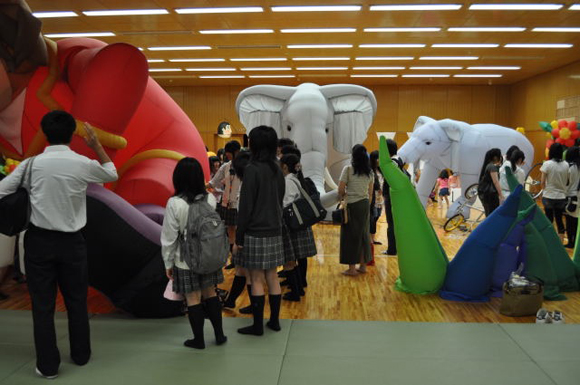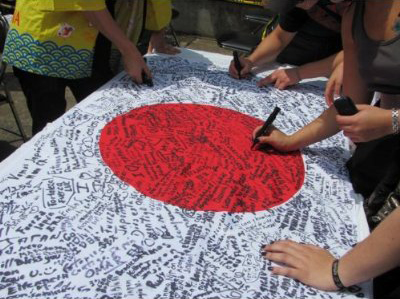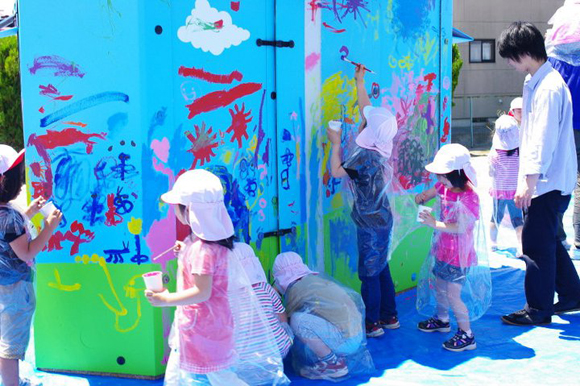An Uncertain Future- Art after the Great East Japan Earthquake
M-KOS sends sincere commiserations to all the people affected by the 2011 Great East Japan Earthquake.

Art charity event organized by Artists’ Action for Japan in Ibaraki prefecture, May 2011. Courtesy of Artists’ Action For Japan
The art scene in Japan has been changing dramatically since the recent chain of catastrophic events – the Great East Japan Earthquake, tsunami and Fukushima 1 nuclear power plant meltdown – which filled news networks around the world. These particularly devastated the Tohoku area, the seacoast areas of Iwate, Miyagi, and Fukushima prefectures. According to the Agency for Cultural Affairs, five national heritage sites were affected, such as the Zuigan-ji Temple in the Miyagi Prefecture, as well as damaging 143 important cultural properties. The well-known RokkakudÅ temple, a hexagonal wooden retreat constructed in 1905 was swept off in the gigantic tsunami that occurred in the Izura coast, in the Ibaraki prefecture. This small yet historical architecture was constructed by Tenshin Okakura (1863-1913), a key contributor to the development of the arts in Japan. Responsible for the conservation of this temple, Ibaraki University has set up funds for reconstructing a new RokkakudÅ. They have already started collecting building materials left ashore by the sea. The university states: ‘we are convinced that Restoration of Rokkakudo would be a symbol of revival from the earthquake and tsunami’.

Tenshin Okakura’s Rokkakudo temple before swept off in the gigantic tsunami in the Izura coast, in the Ibaraki prefecture. Photo via tripadvisor
It has been reported that over 160 museums were damaged according to saveMLAK. The Agency for Cultural Affairs has put together rescue teams of experts, including curators and conservators, to restore even or re-locate cultural properties and museum collections in other institutions. Since the March 11 events, around 20 museum exhibitions have been cancelled. The Exhibitions ’Birth of the Impressionist School’ at the Hiroshima Prefectural Art Museum as well as ‘Maurice Denis’ at Yamanashi Prefectural Museum of Art were both planned for this April, but have been cancelled due to safety and conservation concerns, raised by Agence France-Museums. Similarly, the Giorgio Morandi Exhibition at Toyota Municipal Museum of Art was called off because the Italian company in charge of insurances refused to cover the works. Considering the nuclear crisis is still ongoing, no one knows how long it will take to see works of art traveling from overseas into Japanese museums, in similar proportions to before the earthquake. Only limited amounts of information are available regarding the current situation of museums in Japan, their future remains uncertain, but one could say that the art scene and the role of museums are now forced to adapt. Another problem for these institutions is about reducing their electric energy consumption, under the voluntary and government-ordered power saving schemes. Their heavy reliance on air-conditioned climate control for the long-term preservation of collections needs to be addressed urgently, as some the country’s nuclear reactors are now shut.

Four months after the earthquake and the tunami – view from Kesennuma in the Miyagi prefecture. Photo via「ã¯ã˜ã‚ã®ä¸€æ©ã€
Since the earthquake, great efforts were undertaken to contribute to the relief operations at the individual, household, national, regional and global levels. We citizens and residents of Japan are all aware of the need to join together to overcome their current crisis. Four months now have passed and reconstructions are gradually progressing yet many issues remain unresolved, including the aftertreatment of nuclear plant facilities and the ongoing political instability. Questions such as ‘what can I do?’ and `how can I…?’ all the time get stuck in our minds, which of course, comprise the minds of artists and creators. Here are some examples of creative individuals, groups and institutions that have utilized their resources, knowledge, creative skills and talents to provide constructive answers.

“Pray 4 Japan” book
Hiroyuki Tsuruta, a 20 year old university student and a webmaster created a site called prayforjapan.jp in a single night, while being evacuated to a temporary shelter, due to the 11 March power failure in Northern Tochigi. This web site enables supporting messages to be sent to earthquake victims from over 184 different countries, and has become an international bridge between sufferers and supporters of the world. The title for ‘Pray for Japan’ was taken from the first English-language message about the earthquake disaster, posted on twitter. According to Hiroyuki, his idea for making this site was derived from his own experience, as a Twitter and Facebook user. Just after the earthquake, people started to tweet and comment on the earthquake, and send countless supporting messages. Reading hundreds of messages himself, Hiroyuki thought about documenting these, as they could become valuable one day. In his words: ‘treasures for Japan’. Prayforjapan.jp was an instant success as soon as it went online, with over 3 million visitors in the first two days. Hiroyuki recently published a book, gathering together some of the most memorable messages from his site. The book, entitled ‘Pray For Japan-The Day The World Started Praying for Japan’ eventually also became the name of his charity fund.
OLIVE is a wiki-style website available in four different languages. Created by Japanese artists as an earthquake relief effort, this site lists useful information and techniques for quake-survivors. For example, some articles explain ‘How to make a cup from a candy package or a paper bag’, ‘Washing Dishes Effectively with 3 Buckets of Water’ and ‘How to convert an AA battery into a D battery’. Useful pieces of information like these are listed with simple instructions as well as snapshots or illustrations. The tips presented here can all be done out of materials typically found in disaster-stricken areas. A resource originally produced in response to the March 11th quake, it can however be useful for survival situations in other parts of the world.
Artists’ Action for Japan – the Great East Japan Earthquake Charity Drawing Project has been initiated by Tokyo art school students. Their activity has now been extended to many other areas of Japan. The Project organized drawing days in which people interact with art students and volunteer artists, while they are producing drawings for charity sales. So far over 600 students and volunteers have participated and more than 3000 drawings were sold.
Art workshop for children in Ishimaki organized by Artists’ Action for Japan. June 2011
Tohoku Earthquake Appeal Arts Action 3331 is a project by 3331 Arts Chiyoda. This is Japan’s first community-based, multidisciplinary arts center. 3331 offer spaces within their renovated school building for all sorts of creative activities such as exhibitions, screenings and workshops going towards supporting the relief efforts. This artist-centered community organization seems to know what artists need most. Their way of supporting artists is simple yet greatly encourages them to be creative in finding avenues to raise funds. Numerous Tohoku Earthquake charity activities have already been held.
Mori Art Museum, one of the largest commercially run contemporary art museums, took the lead in organizing the Disaster Relief Charity Talk which was held on 26th March. The talk followed with a charity sale selling works by Yoko Ono, Ilya and Emilia Kabakov, Kusama Yayoi, Nara Yoshitomo, and Miyajima Tatsuo. Their most recent charity talk session was on 23rd July, in which artists, designers and architects were brought together to discuss and deliver proposals for the reconstruction.
In mid April, six commercial galleries in the Kiyosumi Gallery Complex gathered together and organized the “Silent Art Auction†including Tomio Koyama and Taka Ishii. 123 art works by 109 artists including Yoshitomo Nara, Nobuyoshi Araki, Richard Tuttle, Franz Ackermann raised about $514,000 (€354,000), the proceeds of which were donated to NPO Japan Platform.
“Future Auction†was co-organized between Tokyo Wonder Site and “ACT FOR JAPAN“, a 3.11 reconstruction support action facilitated by a multitude of artists and creators. A unique form of auction, “Future Auction” operates by enabling the website visitors to bid for the “production rights for the future” by featured photographers and artists, rather than purchasing already-made works. Here also all proceeds go to the Japan Earthquake: Think the Earth Fund. While the final subject matter of the works depend on the artists; Future Auction have set preliminary ideas and concepts, to be altered after conversations with the artists.

Mobile exhibition organized by Daylily Art Circus in Fukushima prefecture, June 2011. Courtesy of Daylily Art Circus
The Northeast Japan Earthquake Restoration Fund has been set up with the aims to support national arts and heritage projects. The fund also help to re-build and restore damaged cultural resources in the disaffected areas.
Arts NPO Aid has been set up for collecting donations to support non-profit art activities. The organization aims to build networks between artists willing to resume their artistic activities and learning centres wishing to work with them within a relief activity.
Daylily Art Circus is a mobile exhibition project, traveling across Western and Northern Japan, carrying artworks by seven Japanese artists and setting up temporary exhibitions in museums, public town centers and schools, visiting different cities and towns almost everyday. They also organize art charity events in Western and Central Japan, with the proceeds donated to the earthquake affected area in the North East. Daylily originally refers to a flower symbolizing Renewal and Regeneration.
Text by Hana Sakuma
Hana Sakuma was born in Japan in 1970. Based in London between 1993 and 2010, she currently lives in Kobe and works at Kobe Design University, Japan. She holds a PhD at Chelsea College of Art & Design and a MFA in Sculpture at Slade School of Fine Art in London. She works as an artist, researcher and art writer.

Detail from “Pray 4 Japan“

